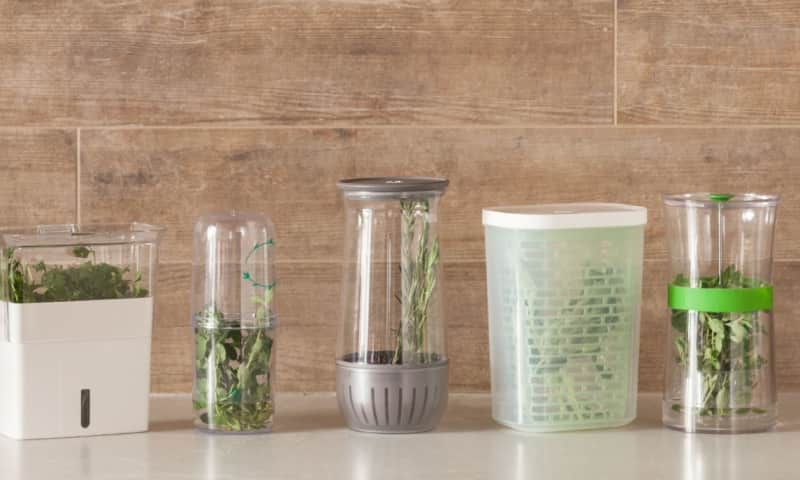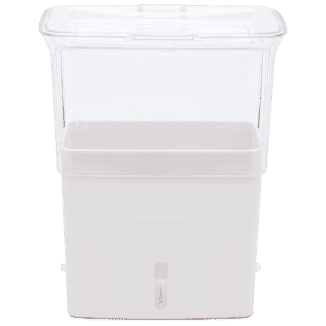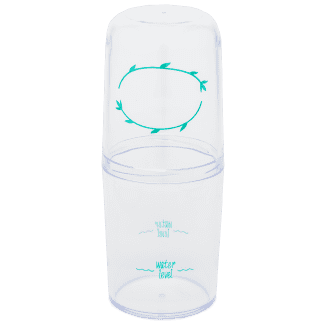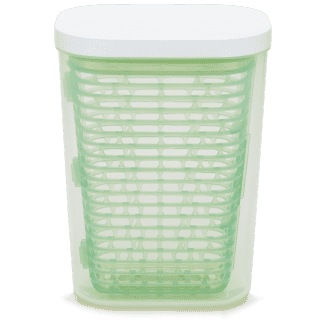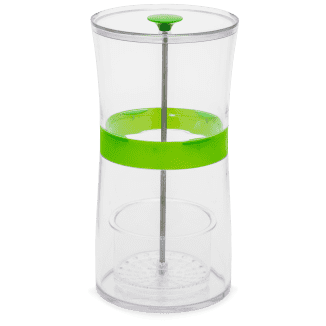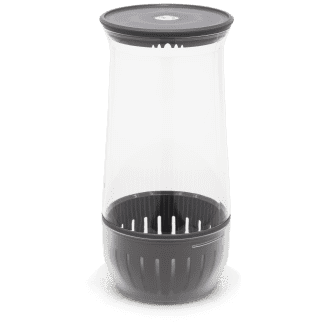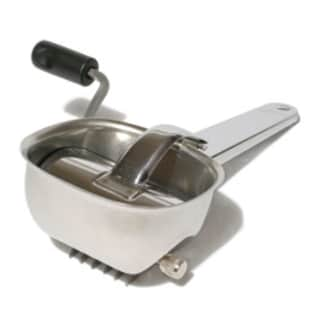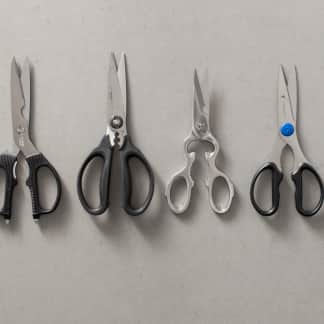Herb keepers are containers designed to extend the life span of herbs, allowing you to use an entire bunch instead of finding it later, slimy and wilted. Resembling covered vases, they hold the herb stems in water while keeping the stalks and leaves neatly contained and protected. We previously evaluated herb keepers and named the Norpro Herb Keeper our winner, but with new models on the market, we decided to retest. We selected five models, priced from $14.86 to $30.47, and tested each one with cilantro (a tender herb) and thyme (a hardy herb). We stored two of every model in the refrigerator—one on a shelf and one in the door—each holding one bunch of cilantro and one of thyme. Curious if the herb keepers would work outside the refrigerator, we also used them on the counter with basil, a tender herb that is typically stored at room temperature.

Our science editor explained that these openings may be advantageous because they can help reduce humidity and condensation . . .
We loaded each herb keeper according to its instructions, adding enough water to cover the bottoms of the stems without going over the maximum water fill line. For comparison, we also stored one bunch each of basil, cilantro, and thyme according to the test kitchen’s preferred methods: We placed basil cuttings in a glass Mason jar with enough water to cover the stems and left the jar on the counter, and we wrapped bunches of cilantro and thyme cuttings in dampened paper towels and stored each separately in a zipper-lock bag. We checked the herbs daily, looking for any signs of spoilage. We diligently removed any wilted or dead leaves and changed the water whenever it started to look discolored. For the herbs stored in zipper-lock bags, we changed the paper towels once during testing, as the towels had ripped. Finally, we noted when there were no longer enough usable herbs—a couple of leaves of basil; just a few stalks of cilantro and thyme—in a given bunch.
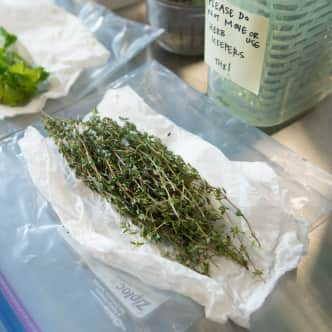

Do Herb Keepers Really Work?
Within 15 days, all the basil stored in keepers on the counter had turned brown, wilted, or developed a fuzzy coating. By comparison, after 50 days of careful pruning and water-changing, there were still a few usable green leaves in the Mason jar, also stored on the counter. Cilantro and thyme stayed fresh in the refrigerated herb keepers for at least 46 days. The test kitchen method also turned in impressive numbers, maintaining these two herbs for 40 and 46 days, respectively.
When it came to evaluating the herb keepers that held the refrigerated herbs, our winner slightly outperformed the competition. Its design may have contributed to this success, as it was the only model with vents; there are L-shaped openings in each corner of the lid. Our science editor explained that these vents may be advantageous because they can help reduce humidity and condensation, which in turn reduces the risk of fungi prospering and infecting the leaves.


Ease Of Use Is Critical
The biggest difference among the herb keepers was access—how easy it was to add or remove herbs, which is important if you want to use up a large bunch in small amounts. Some models were a pain to use. The worst was a tall cylindrical keeper with a lid that required us to reach our hands—and part of our arms—inside to grasp the herbs, or to pull the whole bunch out by the tops. Two other models with lids and removable inserts were slightly better, but these didn’t keep herbs well organized and one of them dripped water every time we removed the basket.
Our favorite herb keepers had a base and top that were roughly the same size, providing access at the midway point of the container (and thus at the midway point of the herb stalks). These made it easier for us to get what we needed, as we could grasp the sturdy stalks instead of the tender leaves. The best model had a lidded top half that collapsed down, meaning that we could opt to open just the lid or slide the whole top down. It was also the only product with removable dividers that helped keep herbs neatly confined.

Our Favorite Herb Keeper
After almost two months of carefully tending to herbs in each of the keepers, we still liked our old favorite, the Norpro Herb Keeper ($14.86). However, a newcomer, the Cole & Mason Fresh Herb Keeper ($17.31), edged it out thanks to a few extra features. Its top can be lowered for easy access to the herbs and raised to avoid crushing tall stalks. Its convenient removable dividers allowed us to separate and corral herbs, making for one organized container. This model didn’t spill or drip water, and it kept herbs looking perky throughout testing: cilantro and thyme stayed fresh for upwards of eight weeks; basil lasted for about 10 days.

That said, we were very impressed with our test kitchen DIY methods, which kept cilantro and thyme bunches fresh for more than five weeks and basil fresh for more than 50 days. Our takeaway? We don’t think you need to buy a dedicated herb keeper when you can easily store herbs using either a zipper-lock bag and a few paper towels or a simple glass Mason jar. The main advantage of an herb keeper is its hard shell, which protects herbs from getting squished in the refrigerator. If that’s a concern, a dedicated herb keeper may be a better option.
- Easy to add and remove herbs
- Has vents in lid
- Includes removable dividers to keep herbs neat
- Kept cilantro and thyme fresh for more than 50 days
- Fits in refrigerator door
- Doesn’t drip or spill
- Store 1 bunch basil on counter
- Store 1 bunch each cilantro and thyme on shelf in refrigerator
- Store 1 bunch each cilantro and thyme in door of refrigerator
- Knock over (empty) in refrigerator 5 times
- Push off counter (empty) 3 times
- Wash 10 times according to manufacturer instructions
